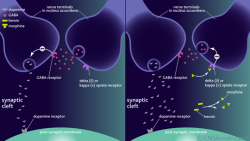With heroin and prescription pain pill addictions steadily on the rise, most everyone has heard the word “opiate” in one context or another. While heroin and prescription pain pills do fall within the opiate category, opiates actually encompass yet another category of drugs, known as opiate antagonists.
Opiate antagonists also come in prescription form, but produce different effects than their prescription pain pill counterparts. What heroin, prescription pain medications and opiate antagonists do have in common is how they interact with the brain’s chemical processes.
Interestingly enough, opiate antagonists have proven effective treatments for opiate addiction under certain circumstances. Opiates, in general, have such far-reaching effects on the mind and body making opiate antagonists just as formidable as their counterparts. As with any prescription-based drug, opiate antagonists do come with their own sets of drawbacks and precautions.
Opiate Agonists vs. Opiate Antagonists
Opiates come from naturally-occurring alkaloids found in the opium poppy seed plant. Most every opiate in existence, both natural and synthetic, has been derived or formulated from the poppy seed plant.
These alkaloid agents possess the same pain-relieving properties as the brain’s own endorphin chemicals. Natural opiates come directly from plant alkaloids, some of which include:

Opioid antagonists and opioid agonists have opposing functions.
- Codeine
- Morphine
- Opium
- Heroin
- Thebaine
- Oripavine
Also known as opiate agonists, this group encompasses most every addictive-type opiate drug. Agonist drugs fully stimulate the cell receptor sites that release endorphin chemicals.
Cell receptor sites exist in the brain, the central nervous system and also in the body’s digestive tract. Over time, the effects of opiate agonists on endorphin levels in the brain and body result in widespread chemical imbalances.
According to a Yale School of Medicine, synthetic and semi-synthetic-type opiate agonists produce the same effects as natural opiates though they may vary in strength and intensity. These drugs include –
- Percocet
- Dilaudid
- Oxycodone
- Hydrocodone
- Hydromorphone
The addictive effects of agonist-type opiates result from their ability to force cells sites to release endorphin chemicals. Over time, cell sites lose their ability to function on their own as site structures start to deteriorate from overuse. Opiate antagonists are designed to undo or block the effects of opiate agonists.
Cell Receptor Site Interactions
As synthetically made drugs, opiate antagonists interact with the same brain cell sites as addictive opiate drugs without triggering the same abuse/addiction cycle. Antagonists differ in that these drugs stimulate cell sites in different ways.
Addictive opiates stimulate specific receptor sites on brain cells, which cause large amounts of endorphin chemicals to be released into the central nervous system. Antagonist-type drugs are designed to either block these same receptor sites or stimulate other types of cell receptors.
In general, opiates bind to receptor sites, which in turn trigger certain cell responses. In this respect, some opiates can form a stronger bond with cell sites than others.
The drug that forms the strongest bond can override the effects of the other drug. These interactions characterize how antagonist-type opiates can be used as treatments for opiate addiction.
Opiate Antagonist Uses
According to the National Institute on Drug Abuse, addiction relapse rates run neck-and-neck with relapse rates for chronic medical conditions, such as diabetes, asthma and hypertension. Relapse rates run anywhere from 60 to 80 percent for addiction as well as for chronic medical conditions.
In effect, addiction functions as a disease-like condition. Opiate addictions in particular, leave those in recovery highly susceptible to relapse for months or years after they stop using.
Opiate antagonists are used to counteract the effects of addictive opiate drugs in various ways. Some opiate antagonists block the effects of addictive opiates, while others can actually reverse the effects of addictive opiates in cases of overdose.
These effects stem from how opiate antagonists interact with cell receptor sites. For people recovering from chronic opiate addiction, opiate antagonists can block the effects of addictive opiates in cases where a person does relapse. By doing so, opiate antagonists prevent further damage to brain cell functions while reducing the risk of continued drug use.
Types of Opiate Antagonists
Full Antagonists
Full opiate antagonist drugs work by blocking cell receptor sites and preventing addictive opiates from binding to these sites. Full antagonists commonly used in opiate addiction treatment include –
- Naltrexone
- Naloxone
- Vivitrol
Since these medications work as blocking agents, no endorphin chemicals are released so there’s no risk of becoming addicted. Over time, these drugs work to reduce a person’s cravings for addictive opiates.
Vivitrol also contains naltrexone, only it’s administered in injection form instead of as a pill. According to the New York State Office of Alcoholism & Substance Abuse Services, one injection of Vivitrol can curb drug cravings for up to 30 days at a time. For someone who has a history of drug relapse episodes, these medications can go a long way towards helping him or her maintain abstinence.
Partial Agonists
Partial agonist-type opiates both block and stimulate endorphin secretions, but at a controlled rate. When used as an opiate antagonist, the blocking effects work to prevent someone in recovery from relapsing while the slow release of endorphins works to relieve withdrawal effects.
Partial agonists commonly used in addition treatment include –
- Levallorphan
- Nalorphine
Partial agonists are used in detox treatment as well as for long-term maintenance treatment. Someone with a long history of opiate addiction will likely experience severe withdrawal and drug cravings effects during detox. Partial agonists can provide a certain degree of relief from uncomfortable withdrawal effects. As long-term maintenance treatments, partial agonists help support damaged brain chemical processes, which in turn reduce withdrawal and drug cravings effects.
Considerations
While opiate antagonists can provide much needed relief from the aftereffects of opiate addiction, these drugs may produce a certain side effect known as dysphoria in some people. Dysphoria manifests as a profound state of discontent or uneasiness.
A flat affect or inability to experience any form of emotion most characterizes dysphoria. Over time, this condition can cause feelings of agitation, anxiety and depression to take shape. While not everyone will experience this side effect, these symptoms can further aggravate the desire to resume drug use in cases where dysphoria develops.









